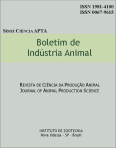Repeated measures in the study of growth and ultrasound carcass traits in cross heifers
DOI:
https://doi.org/10.17523/bia.v71n3p200Keywords:
hip height, longissimus muscle area, chest circumference, covariance structure, ordinary polynomialsAbstract
The aim of this paper was to study the development of carcass traits obtained by ultrasound, weight, chest circumference and hip height by longitudinal data of two genetic groups of heifers. These data were analyzed by different structures of residual (co)variance consider homogeneity or heterogeneity of (co)variances to better represent the variability between and within individual observations over the time. The traits were obtained in 60 animals ½ Braunvieh x ¼ Santa Gertrudes x ¼ Nelore and 60 animals ½ Santa Gertrudes x ½ Nelore. The traits were evaluated at intervals of 28 days. The comparison was done with several models, based on the criterion SBC (Schwarz€™s Bayesian Criterion) with the goal of identifying structures of residual (co)variance more appropriate to best represent the variation of the measures within individuals. Later, as the animals were measured at different ages, it was evaluated the most appropriate model to regress these traits as a function of age, using ordinary polynomials and verifying the need for different curves for each genetic group. The results indicated that it should consider different structures of residual (co)variance to better represent the variability between and within individualobservations. For weight, hip height, chest circumference and longissimus muscle area traits there are differences in the genetic group over the time.Downloads
Downloads
Published
Issue
Section
License
Os autores não serão remunerados pela publicação de trabalhos, pois devem abrir mão de seus direitos autorais em favor deste periódico. Por outro lado, os autores ficam autorizados a publicar seus artigos, simultaneamente, em repositórios da instituição de sua origem, desde que citada a fonte da publicação original seja Boletim de Indústria Animal. A revista se reserva o direito de efetuar, nos originais, alterações de ordem normativa, ortográfica e gramatical, com vistas a manter o padrão culto da língua e a credibilidade do veículo. Respeitará, no entanto, o estilo de escrever dos autores. Alterações, correções ou sugestões de ordem conceitual serão encaminhadas aos autores, quando necessário. Nesses casos, os artigos, depois de adequados, deverão ser submetidos a nova apreciação. As opiniões emitidas pelos autores dos artigos são de sua exclusiva responsabilidade. Todo o conteúdo deste periódico, exceto onde está identificado, está licenciado sob a Licença Creative Commons Attribution (CC-BY-NC). A condição BY implica que os licenciados podem copiar, distribuir, exibir e executar a obra e fazer trabalhos derivados com base em que só se dão o autor ou licenciante os créditos na forma especificada por estes. A cláusula NC significa que os licenciados podem copiar, distribuir, exibir e executar a obra e fazer trabalhos derivados com base apenas para fins não comerciais.













